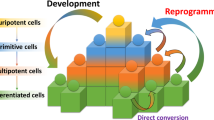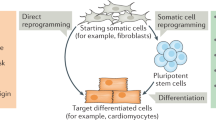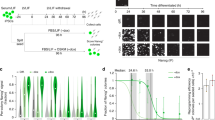Abstract
Reprogramming of mouse and human somatic cells can be achieved by ectopic expression of transcription factors, but with low efficiencies. We report that DNA methyltransferase and histone deacetylase (HDAC) inhibitors improve reprogramming efficiency. In particular, valproic acid (VPA), an HDAC inhibitor, improves reprogramming efficiency by more than 100-fold, using Oct4-GFP as a reporter. VPA also enables efficient induction of pluripotent stem cells without introduction of the oncogene c-Myc.
This is a preview of subscription content, access via your institution
Access options
Subscribe to this journal
Receive 12 print issues and online access
$209.00 per year
only $17.42 per issue
Buy this article
- Purchase on Springer Link
- Instant access to full article PDF
Prices may be subject to local taxes which are calculated during checkout



Similar content being viewed by others
References
Takahashi, K. & Yamanaka, S . Cell 126, 663–676 (2006).
Okita, K., Ichisaka, T. & Yamanaka, S . Nature 448, 313–317 (2007).
Maherali, N. et al. Cell Stem Cell 1, 55–70 (2007).
Wernig, M. et al. Nature 448, 318–324 (2007).
Takahashi, K. et al. Cell 131, 861–872 (2007).
Yu, J. et al. Science 318, 1917–1920 (2007).
Nakagawa, M. et al. Nat. Biotechnol. 26, 101–106 (2008).
Park, I.H. et al. Nature 451, 141–146 (2008).
Lowry, W.E. et al. Proc. Natl. Acad. Sci. USA 105, 2883–2888 (2008).
Kishigami, S. et al. Biochem. Biophys. Res. Commun. 340, 183–189 (2006).
Rybouchkin, A., Kato, Y. & Tsunoda, Y . Biol. Reprod. 74, 1083–1089 (2006).
Blelloch, R. et al. Stem Cells 24, 2007–2013 (2006).
Szabo, P.E., Hubner, K., Scholer, H. & Mann, J.R . Mech. Dev. 115, 157–160 (2002).
Wernig, M., Meissner, A., Cassady, J.P. & Jaenisch, R . Cell Stem Cell 2, 10–12 (2008).
Acknowledgements
D.A.M. is a Howard Hughes Medical Institute Investigator. D.H. is funded by the Helen Hay Whitney Foundation and Novartis Institutes for BioMedical Research. W.G. is funded by the Susan G. Komen Breast Cancer Foundation. A.E.C. is supported by the Jane Coffin Childs Memorial Fund for Medical Research and Merck Research Laboratories. The authors would like to thank J. Lamenzo and A. Kweudjeu for assistance with micoarray analysis, S. Chen for insightful discussions and critical review of the manuscript. We would also like to thank R. Weinberg for support of this study. Some monoclonal antibodies were obtained from the Developmental Studies Hybridoma Bank, which was developed under the auspices of the National Institute of Child Health and Human Development and is maintained by The University of Iowa, Department of Biological Sciences.
Author information
Authors and Affiliations
Contributions
D.H. and D.A.M. conceived the experiments and wrote the manuscript. D.H., R.M., W.G., A.E., M.S. and A.E.C. performed experiments.
Corresponding author
Supplementary information
Supplementary Text and Figures
Figures 1–5, Tables 1,2, Methods (PDF 814 kb)
Rights and permissions
About this article
Cite this article
Huangfu, D., Maehr, R., Guo, W. et al. Induction of pluripotent stem cells by defined factors is greatly improved by small-molecule compounds. Nat Biotechnol 26, 795–797 (2008). https://doi.org/10.1038/nbt1418
Received:
Accepted:
Published:
Issue Date:
DOI: https://doi.org/10.1038/nbt1418
This article is cited by
-
Vitamin C facilitates direct cardiac reprogramming by inhibiting reactive oxygen species
Stem Cell Research & Therapy (2024)
-
Reprogramming of astrocytes to neuronal-like cells in spinal cord injury: a systematic review
Spinal Cord (2024)
-
Genome-wide ATAC-see screening identifies TFDP1 as a modulator of global chromatin accessibility
Nature Genetics (2024)
-
Restricting epigenetic activity promotes the reprogramming of transformed cells to pluripotency in a line-specific manner
Cell Death Discovery (2023)
-
Stem cell-based strategies and challenges for production of cultivated meat
Nature Food (2023)



